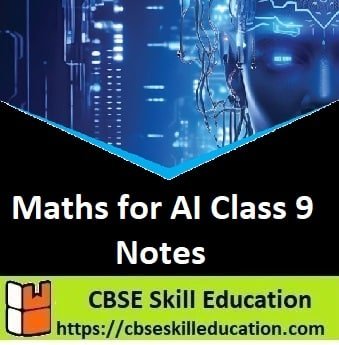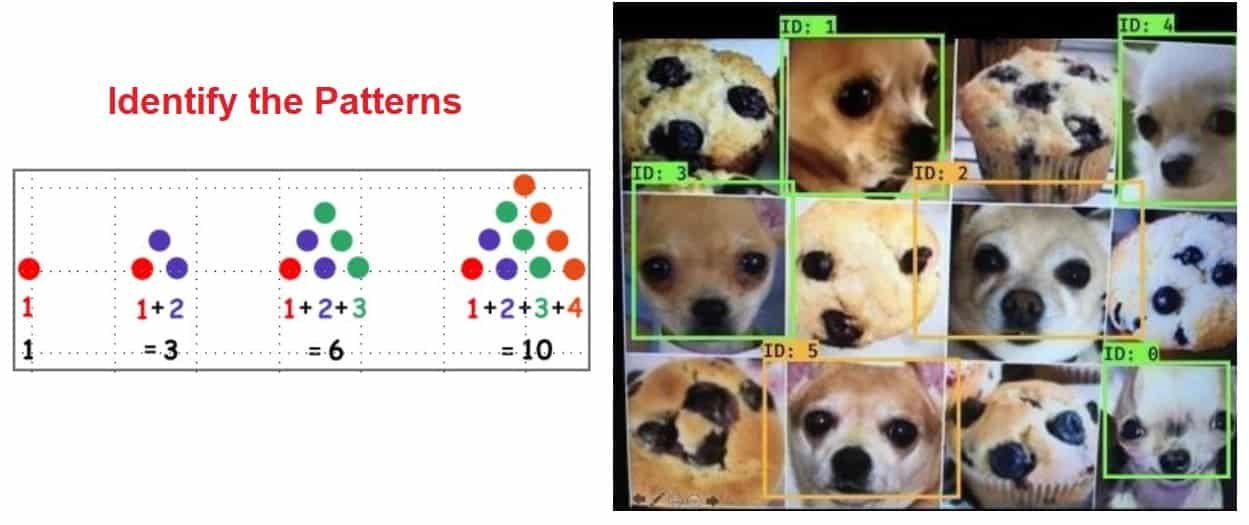Maths for AI Class 9 Notes – The CBSE has changed the previous textbook and the syllabus of Std. IX. The new notes are made based on the new syllabus and based on the New CBSE textbook. All the important Information are taken from the Artificial Intelligence Class IX Textbook Based on CBSE Board Pattern.

Maths for AI Class 9 Notes
Importance of Math for AI
Mathematics is essential for artificial intelligence because it provides the mathematical tools to develop AI algorithms and models. The fusion of mathematics and AI creates a variety of opportunities in the fields of healthcare, finance, robotics, etc.
Math is the study of patterns; math helps to analyze the patterns in the data using AI algorithms. These AI algorithms are based on math. AI algorithms can learn the patterns just like humans. Math is helpful in solving puzzles, organizing data in the number system, and solving patterns in images. Identify the patterns in the following image.

In the above figure, you can find the patterns. In the first image, you can identify the patterns in the number system, and in the second figure, you can also find the patterns in the image. These patterns can be solved by the AI. AI can identify the difference between dogs and muffins just like humans. AI can recognize patterns in numbers, words, pictures, etc.
Uses of Math in AI
Understanding math will help us to better understand AI. AI uses many different types of math formula in algorithm, but we are going to learn below four different types of math in class IX.
- Statistics (Exploring data): Example – What is the middle value of the data? Which is the most common value in the data?
- Calculus (training and improving AI model): Example – which line is more slanted? Which figure covers more area?
- Linear Algebra (finding out unknown or missing values): Example – How many plants are there in total? How many cars are there in a city?
- Probability (predicting different events): Example – what will be the possible results of a coin toss? Will it rain tomorrow?
1. Statistics in AI
Statistics play an important role in analysis and dealing with data in data science. Statistics is used for collecting, exploring, and analyzing the data. It also helps in drawing conclusions from data.
Why statistics in AI
Data can be collected from different sources. Statistics helps the AI algorithm to analyze the data for better understanding, which will be helpful for AI to make predictions.
Applications of Statistics in various real life scenarios
- Disaster Management – Authorities use statistics to alert the citizens residing in places that might be affected by a natural disaster in the near future.
- Sports – The Tokyo 2020 Olympics were postponed due to the Covid-19 pandemic; statistics are used to analyze the COVID cases in Japan during the period of the Olympics.
- Disease prediction – The US government uses statistics to understand which disease is affecting the population the most. For example, the US government can analyze the areas where COVID cases are increasing, which helps to increase the vaccination drive in these areas.
- Weather forecast – Based on past seasons and conditions, statistics can help the AI to forecast the weather.
2. Calculas in AI
Calculus is very important in Machine Learning, which helps the AI algorithm to understand how AI works, in both the learning process and in the thinking process. Calculus helps AI to understand the complex structures by breaking them into different parts and examining how these parts relate to each other. It helps to understand the overall structure and how everything fits together in any complex system.
3. Linear algebra in AI
Linear algebra is the heart of AI. Linear algebra helps the machine to represent the data in a structured way. In AI, this data is often represented as matrices or vectors, which are key concepts of linear algebra.
4. Probability in AI
Probability is a method to tell us how likely something is to happen. For example, when a coin is tossed, there are two possible outcomes, heads (H) or tails (T). The probability equation defines the likelihood of the happening of an event. The probability formula can be expressed as

Now in the above equation, we can say that the probability of the coin landing “heads (H)” is 1/2 and the probability of the coin landing “tails (T)” is 1/2.
Note : If an event is certain or sure to happen, it will have a probability of 1. If an event will never happen or is impossible, it will have a probability of 0.
Probability can be expressed in the following ways-
- Certain events: There are certain events that will happen without a doubt.
- Likely events: The probability of one event is higher than the probability of another event
- Unlikely events: One event is less likely to happen than another event
- Impossible events: There’s no chance of an event happening
- Equal Probability events: Chances of each event happening is same
Probability Applications in various real life scenarios
- Sports : Probability can help analyze batting average in cricket matches; for example, if a batsman scores 45 runs out of 100, then there is a chance that he will score 45 runs in the next match also.
- Weather forecast : The most common example of using probability is weather forecasting. In Google Weather, if you search your location, then Google can forecast that today there is any chance for rain or not; Google gives this forecast in percentage. Google Weather can also forecast snow or clouds in your location.
- Traffic Estimation : Sometimes we get heavy traffic in some of the areas in certain time periods; probability can help to identify the probability of the traffic.
Updated Class 9 AI Notes
Subject Specific skills Notes (40 Marks)
- Unit 1: AI Reflection, Project Cycle and Ethics
- Unit 2: Data Literacy
- Unit 3: Math for AI (Statistics & Probability)
- Unit 4: Introduction to Generative AI
- Unit 5: Introduction to Python
Employability skills Notes ( 10 Marks )
- Unit 1 – Communication Skills
- Unit 2 – Self-Management Skills
- Unit 3 – Basic ICT Skills
- Unit 4 – Entrepreneurial Skills
- Unit 5 – Green Skills
Old Subject Specific skills Notes (For revision)
- Unit 1 – Introduction to Artificial Intelligence (AI)
- Unit 2 – AI Project Cycle
- Unit 3 – Neural Network
- Unit 4 – Introduction to Python
Disclaimer: We have taken an effort to provide you with the accurate handout of “Maths for AI Class 9 Notes“. If you feel that there is any error or mistake, please contact me at anuraganand2017@gmail.com. The above CBSE study material present on our websites is for education purpose, not our copyrights. All the above content and Screenshot are taken from Artificial Intelligence Class 9 CBSE Textbook and Support Material which is present in CBSEACADEMIC website, This Textbook and Support Material are legally copyright by Central Board of Secondary Education. We are only providing a medium and helping the students to improve the performances in the examination.
For more information, refer to the official CBSE textbooks available at cbseacademic.nic.in

cool